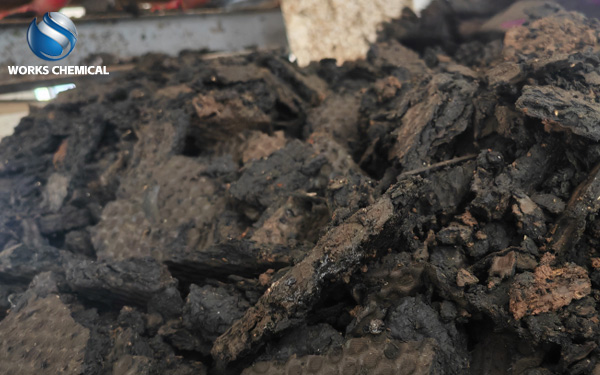
The difficulty in reducing the moisture content of sludge is a common problem in the field of sludge treatment. However, sludge enhancers can significantly improve the dewatering performance of sludge through multiple action mechanisms, greatly reducing the moisture content of the sludge cake. The following is a detailed analysis of the solution for sludge enhancers from aspects such as the mechanism of action, application effect, selection basis, usage precautions and cost-effectiveness:

I. The Core Mechanism of Action of Sludge enhancers
Surface structure modification
By reacting inorganic compounds with the sludge surface, the solid surface load and specific surface area are reduced, and the adsorption of water is decreased.
Destroy the cell walls of bacteria (cell wall disruptors) and organic matter (degreasing agents), release internal moisture, and reduce the viscosity of sludge.
Flocculation enhancement
Sludge surface treatment agents and stripping agents promote the aggregation of sludge particles, forming large and dense flocs, which is convenient for mechanical dewatering.
Synergy effect
When used in combination with equipment such as plate and frame filter presses, it can significantly enhance the filtration efficiency and shorten the sludge pressing cycle.
Ii. Practical application effect: The moisture content is significantly reduced
Deep dewatering case: The sludge enhancer can reduce the moisture content of sludge from over 90% to 40%-60%, and the reduction effect of mud cake is remarkable.
Industrial case: A certain sewage treatment plant in Guangzhou adopted a low-temperature vacuum dewatering and drying process, combined with a sludge conditioning system, which reduced the moisture content from 99.3% to 34%-38%, meeting the requirements for incineration disposal.
Efficiency improvement: The sludge pressing efficiency of the plate and frame filter press is increased by 100% to 500%, the pressing section time is shortened, and the energy consumption of the equipment operation is reduced.
Iii. Key Factors for selection: Matching the nature of the sludge with the process
Adaptation of sludge properties
High organic matter sludge (such as municipal sludge) : Cationic polyacrylamide (CPAM, with an ion degree of 40%-60%) is preferred. Efficient dewatering is achieved through charge neutralization and adsorption bridging.
High inorganic sludge (such as sand washing wastewater) : Anionic polyacrylamide (APAM) or inorganic flocculants (such as PAC) can be used to promote the aggregation of inorganic particles.
Mixed sludge: It is recommended to use inorganic flocculants (pretreatment) and CPAM (deep dewatering) in combination to enhance the overall effect.
Regulation of pH value
The optimal pH range for aluminium salt agents is 5 to 7, while that for high-iron salt agents is wider (pH 6 to 11). If the pH of the sludge deviates from the optimal range of the chemical agent, the type of chemical agent needs to be adjusted in advance or replaced.
Temperature and concentration control
Temperature: Low temperature (<10℃) will inhibit the hydrolysis of the reagent. It is necessary to extend the mixing time or heat the reagent solution.
Concentration: The concentration of organic polymer agents (such as CPAM) should be 0.05%-0.1%. Both too low and too high concentrations will affect the yield of the mud cake.
Iv. Precautions for Use: Ensure effectiveness and environmental compliance
Dosage optimization
Determine the optimal dosage through small-scale tests to avoid excessive dosage leading to increased costs or reduced effectiveness. For example, the dosage of CPAM is generally 0.1-0.5kg per ton of DS.
Mixing and reaction conditions
Ensure that the chemicals are thoroughly mixed with the sludge (for 10 to 20 minutes). After forming flocs, avoid mechanical damage and enter the dewatering equipment as soon as possible.
Environmental compliance
Choose chemicals that meet environmental protection standards to avoid secondary pollution to the water environment. The new regulations in our country require that flocculants for sewage treatment should have the characteristics of high efficiency, low toxicity and low residue.
V. Cost-benefit Analysis: The overall cost has been significantly reduced
Chemical cost: Although the unit price of sludge enhancers may be relatively high, by reducing the use of traditional chemicals such as lime and avoiding equipment corrosion and filter cloth clogging, the overall cost-effectiveness is significant.
Reduced processing costs: For instance, after the application of sludge enhancers, the cost of sludge drying and incineration can be reduced due to the decrease in moisture content, along with transportation and energy consumption expenses. A certain case shows that the actual processing capacity of the drying equipment is 33.3% greater than the designed capacity, and the operation time of each stage can be slightly adjusted according to the actual operation situation, further saving the operation cost.
Vi. Summary and Suggestions
The sludge enhancer significantly improves the sludge dewatering efficiency through mechanisms such as destroying colloids, reducing viscosity, and breaking the wall for degreasing, reducing the moisture content of the sludge cake to 40%-60%. When selecting the type, it is necessary to match the nature of the sludge (organic matter content, pH value), treatment equipment (such as plate and frame filter press) and process conditions, and strictly control the dosage and mixing reaction conditions to achieve the best cost and environmental protection compliance. In practical applications, it is recommended to determine the optimal drug formula and operation parameters through small-scale tests to ensure stable operation and maximize the effect.